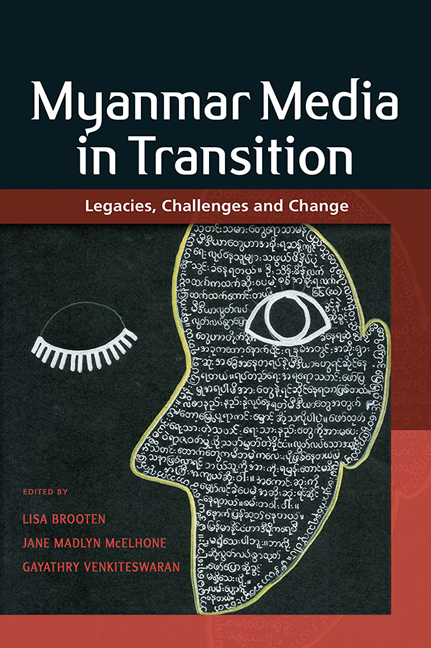Book contents
- Frontmatter
- Contents
- Contributors and Editors
- Burma or Myanmar? A Note on Terminology
- 1 Introduction: Myanmar Media Historically and the Challenges of Transition
- Part I Structural Constraints and Opportunities
- 2 Legal Changes for Media and Expression: New Reforms, Old Controls
- 3 Whispered Support: Two Decades of International Aid for Independent Journalism and Free Expression
- 4 The Changing Face of Print Media: An Interview with News Veteran Thiha Saw
- 5 Privacy Risks in Myanmar's Emerging ICT Sector
- Part II Journalism in Transition
- Part III Creative Expression
- Part IV Society and Media
- Epilogue: Media Studies in Myanmar – Where Do We Go from Here?
- Index
2 - Legal Changes for Media and Expression: New Reforms, Old Controls
from Part I - Structural Constraints and Opportunities
Published online by Cambridge University Press: 07 September 2019
- Frontmatter
- Contents
- Contributors and Editors
- Burma or Myanmar? A Note on Terminology
- 1 Introduction: Myanmar Media Historically and the Challenges of Transition
- Part I Structural Constraints and Opportunities
- 2 Legal Changes for Media and Expression: New Reforms, Old Controls
- 3 Whispered Support: Two Decades of International Aid for Independent Journalism and Free Expression
- 4 The Changing Face of Print Media: An Interview with News Veteran Thiha Saw
- 5 Privacy Risks in Myanmar's Emerging ICT Sector
- Part II Journalism in Transition
- Part III Creative Expression
- Part IV Society and Media
- Epilogue: Media Studies in Myanmar – Where Do We Go from Here?
- Index
Summary
In 2012, Yangon was abuzz with meetings and conferences on media development — something unheard of during the military regime. These meetings followed public announcements by the quasi-civilian Thein Sein government installed in March 2011 of a reform agenda that would include improvements to the media laws. According to the former information minister Ye Htut, these planned reforms date back to 2007, under the former military dictator Than Shwe, when the junta studied options for legal reform (Mclaughlin 2014), while Kean (2018) places the start of the change in 2004 after a high-profile purge of military intelligence. When the National League for Democracy (NLD) formed the government in 2016, expectations were high that technical and procedural problems with the laws and their enforcement would be reviewed and addressed (Htet Naing Zaw 2016). Yet civil society has been disappointed by the lack of political will to bring the laws in line with international norms and standards. Instead, the NLD-led government has continued to use criminal laws to silence journalists and critics. Globally, the media development sector has adopted a rather formulaic approach regarding reform, placing faith in problematic legislative and judicial systems as the arbiters of the practices and regulation of speech and expression. The emphasis that national and international actors in Myanmar place on laws as fundamental to the transition is thus not uncommon, yet it is questionable, especially in a country where the judicial process has been used to imprison critics and censor the media.
This chapter provides an overview of the laws related to media and free expression introduced or changed in Myanmar since 2011. We begin with a review of the literature on media legal reforms during transitions, followed by a mapping of the media laws in Myanmar and issues related to the reform process. We argue that the legal framework, while attempting to undo the controls of the past, has not been radically transformed. The paradigm of control has prevailed during this transition period, and the use of criminal laws has rendered some of the legal changes inadequate to support freedom, public interest, diversity and pluralism in relation to media and expression.
- Type
- Chapter
- Information
- Myanmar Media in TransitionLegacies, Challenges and Change, pp. 59 - 94Publisher: ISEAS–Yusof Ishak InstitutePrint publication year: 2019



